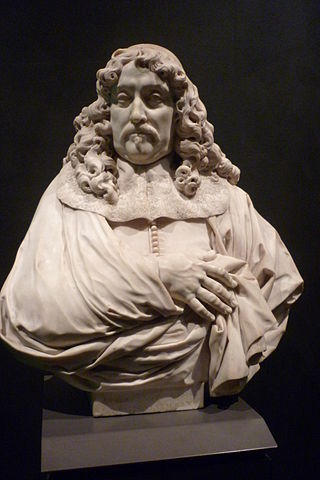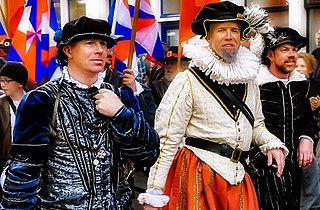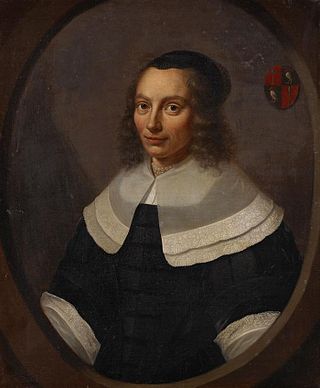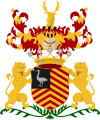
Cornelis de Graeff, often named Polsbroek or de heer van (lord) Polsbroek during his lifetime was an influential regent and burgomaster (mayor) of Amsterdam, statesman and diplomat of Holland and the Republic of the United Netherlands at the height of the Dutch Golden Age.

Catharina Pietersdr Hooft was a woman of the Dutch Golden Age. She became famous at a very early age, when she was painted by Frans Hals.

De Graeff is an old Dutch patrician and noble family,

Andries de Graeff was a regent and burgomaster (mayor) of Amsterdam and leading Dutch statesman during the Golden Age.

Dirck Jansz Graeff, also Diederik Jansz Graeff, Lord of the manors Valckeveen and Vredenhof, was a patrician, wholesaler, shipowner, politician and large landowner. He became an important figure of the Protestant Reformation, member of the Reformed Church, supporter of the Geuzen and the Protestant-minded community of wholesale merchants, and a confidant of William I of Orange. Graeff was the founder of a regent dynasty of the Dutch Golden Age and the short time of the First Stadtholderless Period that retained power and influence for centuries and produced a number of ministers. He was the first Burgomaster of Amsterdam from the De Graeff family.

Pieter de Graeff was a Dutch aristocrat of the Dutch Golden Age and one of the most influential pro-state, republican Amsterdam Regents during the late 1660s and the early 1670s before the Rampjaar 1672. As president-bewindhebber of the Dutch East India Company, he was one of the most important representatives and leaders of the same after the Rampjaar.

Johan de Graeff, also Jan de Graeff - patrician of Amsterdam, Free Lord of Zuid-Polsbroek - was a member of the De Graeff - family from the Dutch Golden Age. His political Position was that of the Dutch States Party.

Lenaert Jansz de Graeff, also Lena(e)rt Jansz Graeff, Leendert de Graeff and Leonhard de Graeff belonged to the powerful Amsterdam patriciate. He was one of the leaders of the Protestant Reformation in Amsterdam, a friend of Henry, Count of Bréderode, the "Grote Geus", and his deputy as vice-general-captain of Amsterdam, and according to a family tradition identified with "Monseigneur de Graeff", a privateer and captain of the Sea Beggars during the Capture of Brielle. In recent research, Lenaert Jansz de Graeff is described as one of the leaders of the Sea Beggars alongside Admiral William II de la Marck, Lord Lumey and Willem Bloys van Treslong. His character was also used in a historical novel about De Grote Geus.

Cornelis de Graeff was a member of the family De Graeff, a prominent regent family from the Dutch Golden Age. He hold the title 20st Free Lord of Purmerland and Ilpendam.

Jacob Dircksz de Graeff, free lord of Zuid-Polsbroek was an illustrious member of the Dutch patrician De Graeff family. He belonged to States Faction and was an influential Amsterdam regent and burgomaster (mayor) of the Dutch Golden Age.

KnightCornelis de Graeff was a Dutch nobleman and a water board member of the Zijpe and Haze Polder.

Jacob de Graeff was a member of the De Graeff-family from the Dutch Golden Age. He was an Amsterdam regent and held the title as 20th Free Lord of Ilpendam and Purmerland.

Agneta de Graeff van Polsbroek, was a patrician woman from the Dutch Golden Age. She became known as the mother-in-law of Johan de Witt.

Bicker is a very old Dutch patrician family. The family has played an important role during the Dutch Golden Age. They led the Dutch States Party and were at the centre of Amsterdam oligarchy from the beginning of the 17th century until the early 1650s, influencing the government of Holland and the Republic of the United Netherlands. Their wealth was based on commercial transactions, and in their political commitment they mostly opposed the House of Orange.

Wolfgang von Graben, also Wolfgang de Groben and Wolfgang Grabenski was born in Kornberg castle, Styria and a member of the Austrian nobility. He held the titles as a Lord of Graben, Kornberg, the Lordship Marburg with Obermarburg and Maribor Castle, Radkersburg, Neudenstein, Weinberg and Viscount of Saldenhofen.

Jan Pietersz Graeff was an Amsterdam regent and cloth wholesaler from the 16th century.
Jan Jacobsz Graeff belonged to the Dutch patrician class, and was a member of the executive board of the Zijpe water board.

Joan de Graeff was a Dutch patrician and held the feudal title Free Lord of Zuid-Polsbroek until his sudden death at the age of 19.

Dirk de Graeff was a Dutch 17th-century regent who belonged to the States Party.























